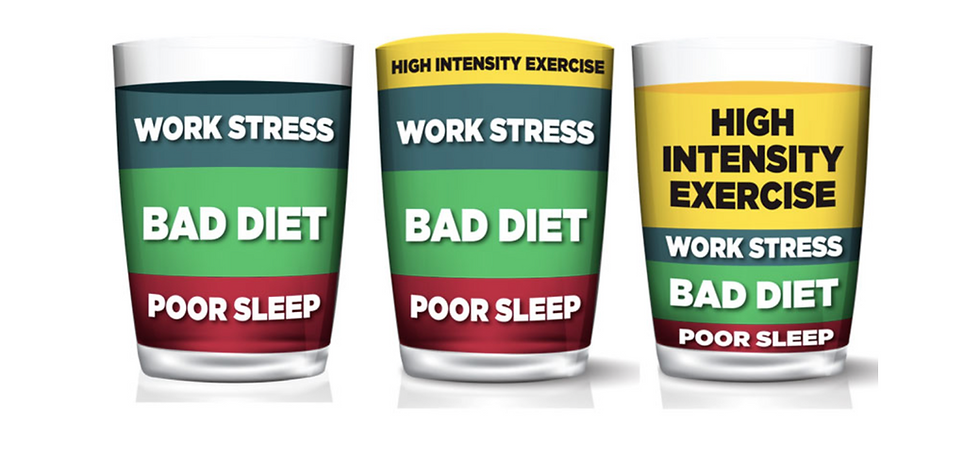Stress, Part 1: Don't fill your cup!
- NateWilliams
- Jun 17, 2020
- 4 min read
This blog is about Allostatic load, the accumulation of stress and an Introduction to Heart rate variability. I've recently re-read some articles around the subject of stress and tried to take this large, complex and debated topic and convert it into a 5 minute simple-to-read post. Part 1 is an introduction to the 'stress cup' theory and hopefully you can take something from the information in the next 2 posts and apply to your own health, training and lifestyle.

"The Stress Cup"is a visual representation of Allostatic load (total stress)
What is allostatic load?
Watch this short video for a "Dummies-guide" to what Allostatic load is. Its way better than the paragraph I tried to write!
What happens when we manage stress effectively?
If we keep our 'stress cup' from becoming full - will we achieve better results? The answer maybe a resounding... Yes! According to Dr. Chris Hardy in the fantastic book Strong Medicine "if you can stay within your stress cup without overflowing it, you can achieve a positive adaptation to your training". Conversely, your body will fail adapt to a training challenges if your stress-cup is permanently 'full' - you will experience allostatic overload. Repeating this scenario over longer periods will cause harmful health consequences far beyond an overtraining situation and may have a severe negative impact of your overall health.

"If your stress cup is permanently full, there is little or no room for positive training adaptations"
Can you have too much of a good thing?
Of course you can. I think this is generally true in a lot of areas of life, especially in training and how it relates to continual progress. We've been sold by modern day fitness trends that "more is better" when it comes to training. Popular Instagram Hashtags like #Beastmode, #nodaysoff and #NoPainNoGain have fuelled the crazed appetite of fitness enthusiasts and lead some hurtling down a path of semi-permanent injuries and pain. Fitness consumers have been pushed towards elite 'twice a day" programs to fit in around their full-time office jobs and the truth is it just doesn't work over the long term for a large majority of people. The analogy of withdrawing cash from your "fitness" bank account and not putting any back in over weeks, months and years is a slippery slope for any person to take on. Overtraining syndrome is a big deal and can take months, even years to recover from.
NOTE: Its key to also mention here that under-training, will not provide enough stimulus for any training adaptations and like most things a balance between Yin and Yang must be sought for optimal results.

Some other examples:
Psychological stress - We need some struggle to become resilient, but too much of it and we can become depressed and anxious.
Nutrition - We need to be adequately nourished but not overly so, since the body will adapt to over-feeding and gain weight.
Sleep - Too little sleep and the body adapts with a negative stress response while new studies are showing that too much sleep (9+ hours) is also bad!

How do you know if you're stressed?
When we complain or hear that someone is 'feeling stressed', this can be a very personal and objective expression and sometimes hard to truly quantify. Each person is unique and will react differently when confronted with daily life stressors like Rude people, negative feedback, strenuous exercise, junk food and workload (etc) - Its really hard to prove how much stress is actually created in individuals in each situation.
Some reported side effects of highly stressed individuals are:
- Low energy.
- Headaches.
- Upset stomach, including diarrhea, constipation, and nausea.
- Aches, pains, and tense muscles.
- Chest pain and rapid heartbeat.
- Insomnia.
- Frequent colds and infections.
- Loss of sexual desire and/or ability.
Some people are extremely resilient and can work through issues and are even able to use negative emotions as fuel to drive more work. While others are not as resilient, react differently to external stressors and rely on the support of others more often. This is merely an observation and not a particularly scientific argument, it's just the way individuals are wired up from birth.
In a nutshell... Stress is a very complex subject and we all have different ways to deal with it.

I couldn't resist using that phrase and not adding this classic movie moment :)
How can we measure stress? HRV - a very quick overview
Heart rate variability (HRV) is the measure of the variation in time between each heartbeat. This variation is controlled by a primitive part of the nervous system called the autonomic nervous system (ANS) and regulates, among other things, our heart rate, blood pressure, breathing, and digestion. The ANS is subdivided into two large components, the sympathetic and the parasympathetic nervous system, also known as the fight-or-flight mechanism and the relaxation response.
Tracking HRV is the most accessible and accurate way to personally monitor your daily stress levels and can be a great tool to motivate behavioural change in people. HRV measurements can help create more awareness of how you live and think, and how your behavior affects your nervous system and bodily functions. While it obviously can’t help you avoid stress, it could help you understand how to respond to stress in a healthier way.

Some of the current leading HRV brands/devices are:
- Whoop strap (wearable)
- ithlete app (with Polar chest strap)
- Oura ring (wearable)
- Elite HRV app (needs strap)
If you want to read more on HRV and/or allostatic load, the full articles are below in sources.
Comment if you have anything to add to the discussion and share with friends/colleagues that may enjoy the content :)
Look out for the next blog on Stress, Part 2: What can you do about it?
Sources:




Comments